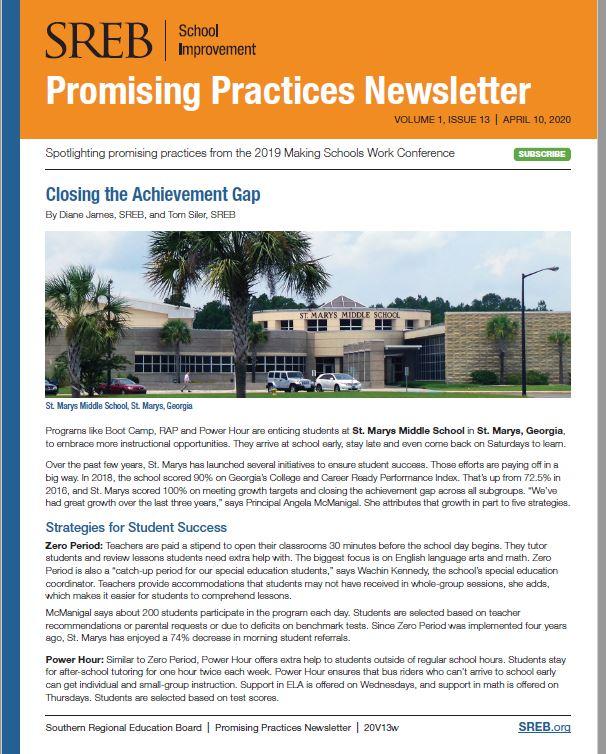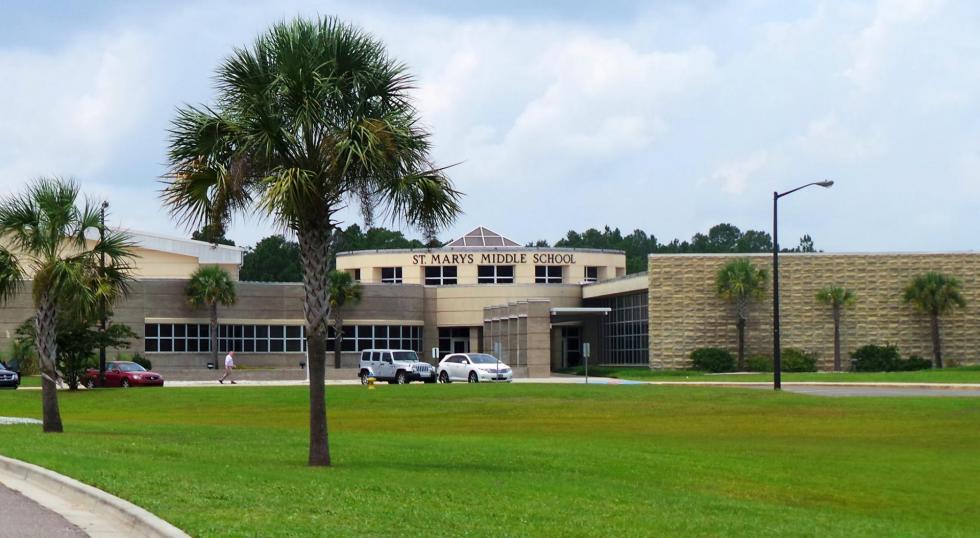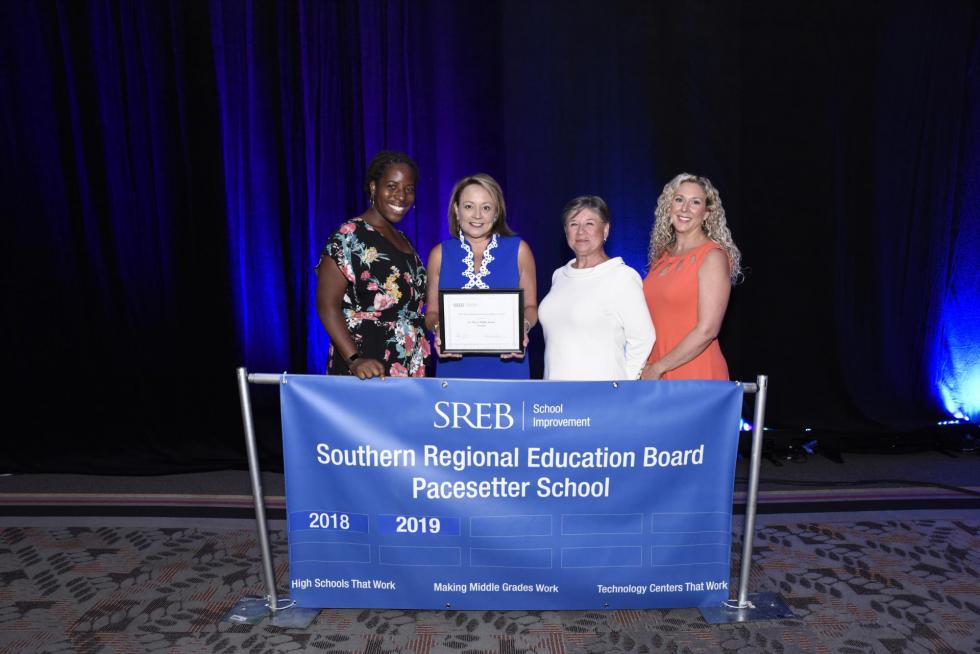Closing the Achievement Gap
Spotlighting promising practices from the 2019 Making Schools Work Conference
 Programs like Boot Camp, RAP and
Power Hour are enticing students at St. Marys Middle
School in St. Marys, Georgia, to embrace more
instructional opportunities. They arrive at school early, stay
late and even come back on Saturdays to learn.
Programs like Boot Camp, RAP and
Power Hour are enticing students at St. Marys Middle
School in St. Marys, Georgia, to embrace more
instructional opportunities. They arrive at school early, stay
late and even come back on Saturdays to learn.
Over the past few years, St. Marys has launched several initiatives to ensure student success. Those efforts are paying off in a big way. In 2018, the school scored 90% on Georgia’s College and Career Ready Performance Index. That’s up from 72.5% in 2016, and St. Marys scored 100% on meeting growth targets and closing the achievement gap across all subgroups. “We’ve had great growth over the last three years,” says Principal Angela McManigal. She attributes that growth in part to five strategies.
Strategies for Student Success
Zero Period: Teachers are paid a stipend to open their classrooms 30 minutes before the school day begins. They tutor students and review lessons students need extra help with. The biggest focus is on English language arts and math. Zero Period is also a “catch-up period for our special education students,” says Wachin Kennedy, the school’s special education coordinator. Teachers provide accommodations that students may not have received in whole-group sessions, she adds, which makes it easier for students to comprehend lessons.
McManigal says about 200 students participate in the program each day. Students are selected based on teacher recommendations or parental requests or due to deficits on benchmark tests. Since Zero Period was implemented four years ago, St. Marys has enjoyed a 74% decrease in morning student referrals.
Power Hour: Similar to Zero Period, Power Hour offers extra help to students outside of regular school hours. Students stay for after-school tutoring for one hour twice each week. Power Hour ensures that bus riders who can’t arrive to school early can get individual and small-group instruction. Support in ELA is offered on Wednesdays, and support in math is offered on Thursdays. Students are selected based on test scores.
Saturday End-of-Grade Boot Camp: One Saturday per month beginning in January, St. Marys opens on Saturday for instruction, learning and play. Staff select students who are “on the bubble” and need additional support to move to the next achievement level. McManigal reports that “cool” teachers are asked to provide instruction. “We ask teachers who have the best relationship with the students to come to Saturday camp because students will attend for teachers they want to please and do well for,” maintains McManigal.
Boot Camp offers a full day of structured activities. From 9 a.m. until noon, students are involved with academic work. From noon until 1 p.m., they eat lunch. After that, participants go to the gym for free play or a game of basketball.
Funding for Saturday Boot Camp comes from special education funds allotted to each school in the Camden School District to increase academic growth. The program places a special emphasis on subgroups of students, including those on free- or reduced-price lunch, African American students and students with disabilities.
RAP (Remediate, Accelerate, Prepare): RAP is “a skinny period every Friday that’s built into the school day,” says McManigal. It runs for four weeks at a time. For the first four weeks, students concentrate on ELA. During the next four weeks, the focus is on math. “It’s very differentiated,” says McManigal. Students are grouped based on their need for remediation or acceleration. Instruction is facilitated by school administrators or retired educators working under contract with the school.
 Strategic
Scheduling: St. Marys eliminated eighth-grade teams in
the 2018-19 school year. In the fall of 2019, seventh-grade teams
were also eliminated. Instead of students taking the same set of
classes with the same group of students and teachers all day,
students have more individualized schedules — much like they will
experience in high school or college. McManigal shares, “Our
growth last year, taking those teams away, was tremendous in
grade eight. Every ELA teacher and every math teacher had high
growth in the [end-of-grade] test scores.”
Strategic
Scheduling: St. Marys eliminated eighth-grade teams in
the 2018-19 school year. In the fall of 2019, seventh-grade teams
were also eliminated. Instead of students taking the same set of
classes with the same group of students and teachers all day,
students have more individualized schedules — much like they will
experience in high school or college. McManigal shares, “Our
growth last year, taking those teams away, was tremendous in
grade eight. Every ELA teacher and every math teacher had high
growth in the [end-of-grade] test scores.”
Not only did students benefit from more individualized schedules, they also gained opportunities to take higher-level honors courses. McManigal points out the school had teachers who were endorsed for gifted education but weren’t teaching gifted level instruction. The lack of teaming also “gave us the opportunity for special ed students to take a higher-level math course and receive services from a different teacher,” says Kennedy.
About St. Mary’s
 A Title I school, St. Marys serves
1,000 students in grades six through eight, 52% of whom receive
free- or reduced-price lunch.
A Title I school, St. Marys serves
1,000 students in grades six through eight, 52% of whom receive
free- or reduced-price lunch.
St. Marys teamed up with SREB seven years ago to make STEM (science, technology, engineering and math) a priority in the school’s teaching and learning. St. Marys was recognized as the first STEM-certified public middle grades school in Georgia — an honor awarded by the Georgia Department of Education to schools that have implemented interdisciplinary instruction, business and community partnerships, and a culture of innovation.
SREB provides St. Marys with coaching and professional development in project-based learning, literacy and math. The school also offers SREB’s Ready for High School courses that prepare eighth graders for high school success.
“We do believe that SREB, the professional learning and the conferences that we’ve attended have helped us be more successful as a school,” says McManigal.
Contact(s): Angela McManigal, amcmanigal@camden.k12.ga.us; Wachin Kennedy, wkennedy@camden.k12.ga.us

